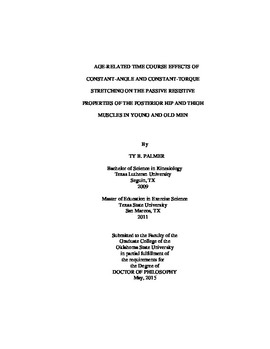| dc.contributor.advisor | Smith, Douglas Boyd | |
| dc.contributor.author | Palmer, Ty B. | |
| dc.date.accessioned | 2016-04-15T21:49:34Z | |
| dc.date.available | 2016-04-15T21:49:34Z | |
| dc.date.issued | 2015-05 | |
| dc.identifier.uri | https://hdl.handle.net/11244/33440 | |
| dc.description.abstract | The purpose of the present study was to examine the acute effects of static stretching at a constant angle (CA) and constant torque (CT) on the passive resistive properties of the posterior hip and thigh muscles in young and old men. Twenty young (mean±SD: age = 24.60 ± 2.98 years) and seventeen old (age = 71.88 ± 3.86 years) men performed 16, 30-s bouts of CA and CT stretching of the posterior hip and thigh muscles using an instrumented straight-leg raise (SLR). SLRs were then performed again at 10, 20, and 30 min following the completion of the stretching protocol. During each SLR, passive stiffness, passive torque, and electromyographic (EMG) amplitude were determined at the second to last common joint angle of the angle-torque curve, and maximum range of motion (ROM) was determined as the point of discomfort but not pain, as indicated by the participant. Three-way mixed factorial ANOVAs (group [young vs. old] x treatment [CA vs. CT] x time [stretch 1 vs. stretch 2 vs. stretch 4 vs. stretch 8 vs. stretch 16 vs. Post10 vs. Post20 vs. Post30]) were used to analyze all passive resistive variables. The present findings revealed that the older men had greater passive stiffness values compared to the young men. No differences were observed between the CA and CT treatments across stretches for passive torque and ROM; however, differential time course effects were observed between treatments for passive stiffness. The CT treatment decreased passive stiffness following one 30-s bout of stretching, whereas for the CA treatment, passive stiffness did not decrease until stretch 8 (4 min of stretching). Moreover, during the first 4 min of stretching, greater reductions in passive stiffness were observed for the CT treatment than the CA treatment. Both treatments showed lower passive stiffness and torque and higher ROM at Post10, Post20, and Post30 for both age groups; however, the old men exhibited significantly greater changes for these variables compared to the young men when collapsed across treatment and time. These findings may have important stretch-related performance and injury risk implications for a variety of populations and settings. | |
| dc.format | application/pdf | |
| dc.language | en_US | |
| dc.rights | Copyright is held by the author who has granted the Oklahoma State University Library the non-exclusive right to share this material in its institutional repository. Contact Digital Library Services at lib-dls@okstate.edu or 405-744-9161 for the permission policy on the use, reproduction or distribution of this material. | |
| dc.title | Age-related time course effects of constant-angle and constant-torque stretching on the passive resistive properties of the posterior hip and thigh muscles in young and old men | |
| dc.contributor.committeeMember | Warren, Aric Jon | |
| dc.contributor.committeeMember | O'Brien, Matthew Scott | |
| dc.contributor.committeeMember | Shaw, Jennifer H. | |
| osu.filename | Palmer_okstate_0664D_13852.pdf | |
| osu.accesstype | Open Access | |
| dc.type.genre | Dissertation | |
| dc.type.material | Text | |
| thesis.degree.discipline | Health, Leisure, and Human Performance | |
| thesis.degree.grantor | Oklahoma State University | |
